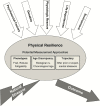Physical Resilience in Older Adults: Systematic Review and Development of an Emerging Construct
- PMID: 26718984
- PMCID: PMC5014191
- DOI: 10.1093/gerona/glv202
Physical Resilience in Older Adults: Systematic Review and Development of an Emerging Construct
Abstract
Background: Resilience has been described in the psychosocial literature as the capacity to maintain or regain well-being during or after adversity. Physical resilience is a newer concept that is highly relevant to successful aging. Our objective was to characterize the emerging construct of resilience as it pertains to physical health in older adults, and to identify gaps and opportunities to advance research in this area.
Methods: We conducted a systematic review to identify English language papers published through January 2015 that apply the term "resilience" in relation to physical health in older adults. We applied a modified framework analysis to characterize themes in implicit or explicit definitions of physical resilience.
Results: Of 1,078 abstracts identified, 49 articles met criteria for inclusion. Sixteen were letters or concept papers, and only one was an intervention study. Definitions of physical resilience spanned cellular to whole-person levels, incorporated many outcome measures, and represented three conceptual themes: resilience as a trait, trajectory, or characteristic/capacity.
Conclusions: Current biomedical literature lacks consensus on how to define and measure physical resilience. We propose a working definition of physical resilience at the whole person level: a characteristic which determines one's ability to resist or recover from functional decline following health stressor(s). We present a conceptual framework that encompasses the related construct of physiologic reserve. We discuss gaps and opportunities in measurement, interactions across contributors to physical resilience, and points of intervention.
Keywords: Disablement process; Frailty; Physical function; Physiology; Successful aging.
Published by Oxford University Press on behalf of the Gerontological Society of America 2015.
Figures



Comment in
-
Resilience Versus Robustness in Aging.J Gerontol A Biol Sci Med Sci. 2016 Nov;71(11):1533-1534. doi: 10.1093/gerona/glw083. Epub 2016 May 4. J Gerontol A Biol Sci Med Sci. 2016. PMID: 27146372 Free PMC article. No abstract available.
-
Response to Ukraintseva et al. Letter: Resilience Versus Robustness in Aging.J Gerontol A Biol Sci Med Sci. 2016 Nov;71(11):1535-1536. doi: 10.1093/gerona/glw137. Epub 2016 Jul 21. J Gerontol A Biol Sci Med Sci. 2016. PMID: 27445404 Free PMC article. No abstract available.
-
Biologic Resilience of Elderly Hospitalized Patients.J Gerontol A Biol Sci Med Sci. 2017 Jan;72(1):140-141. doi: 10.1093/gerona/glw162. Epub 2016 Nov 3. J Gerontol A Biol Sci Med Sci. 2017. PMID: 27811153 No abstract available.
-
Response to Letter From De Alfieri et al.: Biological Resilience of Elderly Hospitalized Patients.J Gerontol A Biol Sci Med Sci. 2017 Jan;72(1):142. doi: 10.1093/gerona/glw161. Epub 2016 Nov 3. J Gerontol A Biol Sci Med Sci. 2017. PMID: 27811154 Free PMC article. No abstract available.
References
-
- Population Ageing and Sustainable Development. 2014. http://www.un.org/en/development/desa/population/publications/pdf/popfac... Accessed June 3, 2015.
-
- Fried LP, Ferrucci L, Darer J, et al. Untangling the concepts of disability, frailty, and comorbidity: implications for improved targeting and care. J Gerontol A Biol Sci Med Sci. 2004;59(3):255–263. - PubMed
-
- Centers for Disease Control and Prevention. Prevalence of disabilities and associated health conditions among adults—United States, 1999. MMWR Morb Mortal Wkly Rep. 2001;50(7):120–125. PMID: 11393491 - PubMed
-
- Rowe JW, Kahn RL. Successful aging. The Gerontologist. 1997;37(4):433–440. - PubMed
-
- Jain S, Sprengel M, Berry K, Ives J, Jonas W. 2014. The tapestry of resilience: an emerging picture. Interface Focus. 4: 20140057. http://dx.doi.org/10.1098/rsfs.2014.0057
Publication types
MeSH terms
Grants and funding
LinkOut - more resources
Full Text Sources
Other Literature Sources
Medical
Miscellaneous

